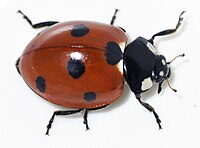
Photo from wikipedia
Simple Summary The diversity of life on Earth is declining due to human decisions and human actions. Scientists have clearly identified categories of human-induced environmental distress, and public awareness is… Click to show full abstract
Simple Summary The diversity of life on Earth is declining due to human decisions and human actions. Scientists have clearly identified categories of human-induced environmental distress, and public awareness is growing, yet science and related media reports are not affecting enough policy change to forestall our impact. Additional approaches need to be taken, and one potent vehicle for eliciting responses is art. Some visual artists have chosen to include insects in their work. Insects are diverse, abundant, ecologically and culturally important to us, and are suffering declines by our hand. These qualities, coupled with insects’ uncanny ability to evoke emotional extremes, marks them as uniquely powerful subjects for artists to convey messages about our relationship with the planet. We surveyed relevant work by 73 artists and found a bias favoring insect art addressing habitat destruction or climate change, and an underrepresentation of art related to several other important categories of environmental destruction. Art favored Hymenoptera over all other insect orders, including orders containing more described species. Noting these misalignments, we see opportunities for artists to more extensively explore insect diversity and the harm we are causing, and for art to increasingly play a complementary role in affecting change in our destructive behavior. Abstract Humans are reshaping the planet in impressive, and impressively self-destructive, ways. Evidence and awareness of our environmental impact has failed to elicit meaningful change in reversing our behavior. A multifaceted approach to communicating human-induced environmental destruction is critical, and art can affect our behavior by its power to evoke emotions. Artists often use insects in their works because of our intimate and varied relationship with this diverse, abundant lineage of animals. We surveyed work by 73 artists featuring insects or insect bodily products to gauge how extensively artists are addressing anthropogenic environmental distress, and what insects they are choosing as subjects in the process. Categories often cited as contributing to species extinction are (1) habitat destruction, (2) invasive species, (3) pollution, (4) human population, and (5) overharvesting. After adding insect-specific categories of (6) decline of insect pollinators and (7) the intentional modification or extermination of insects, we categorized our surveyed works, confirming categorizations with 53 of the living artists. Forty-seven percent of the artists addressed habitat destruction or climate change, but some other categories were severely underrepresented, with almost no work explicitly addressing overpopulation or overharvesting. Artists favored Hymenoptera (62%) over potentially more species-rich orders. Recognizing these biases could alert scientists, artists, and others to more effectively communicate messages of universal importance.
Journal Title: Insects
Year Published: 2022
Link to full text (if available)
Share on Social Media: Sign Up to like & get
recommendations!